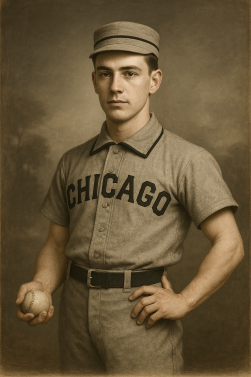The Federal League: 1880
“The Apprentice and the Master”
The fifth year of the Federal League brought both continuity and transformation. The continuity came from Chicago, where Charles W. Garrison’s Base Ball Club once again raised the pennant on the North Side. The transformation came from Harry Taylor, the English-born pitcher who had carried the league through its infancy and now laid down his arm to take up pen, ledger, and storefront.
Taylor Steps Off the Slab
Taylor had retired quietly after the 1878 season, his arm finally spent from years of service. By 1880, he was already a vice-president of the Chicago Base Ball Club, trusted by Garrison to shape the team’s future. More importantly, he had thrown himself into a new enterprise: Taylor’s Sporting Goods Company, a line of base ball equipment that bore his name and promised to rival any manufacturer in the trade. The cranks mourned the end of his pitching days, but Taylor was not leaving the game — merely moving to the side of the ledger where money was made.
Crockett’s Rise
 On the field, Chicago’s fortunes were restored by the emergence of Taylor’s hand-picked protégé, Doug Crockett. Barely twenty years old and a native of Louisville, Crockett had been discovered while Taylor barnstormed and hawked his wares in Kentucky. Signed and groomed under Taylor’s watch, Crockett burst onto the scene in 1880 with a 38–15 record, 1.77 ERA, and 246 strikeouts — all league bests. His only blemish was a league-high 91 walks, a reminder that his power sometimes outpaced his precision.
On the field, Chicago’s fortunes were restored by the emergence of Taylor’s hand-picked protégé, Doug Crockett. Barely twenty years old and a native of Louisville, Crockett had been discovered while Taylor barnstormed and hawked his wares in Kentucky. Signed and groomed under Taylor’s watch, Crockett burst onto the scene in 1880 with a 38–15 record, 1.77 ERA, and 246 strikeouts — all league bests. His only blemish was a league-high 91 walks, a reminder that his power sometimes outpaced his precision.
With Ben Brownfield (18–14) giving the Cyclones a sturdy second option, Garrison’s men had pitching to match their suddenly potent bats. The outfield tandem of Charlie Vanmeter (.337, league batting champion) and Virgil Atwood (.334) ranked first and second in hitting, while captain Morgan “Cap’n” Cook added a steady .300 with 52 RBI from first base. Chicago finished 56–29, comfortably atop the standings.
Cleveland Holds Firm
The Blue Caps of Cleveland refused to go quietly. Nineteen-year-old sensation Mike McCord turned in another brilliant season, going 34–19 with a 2.13 ERA. His partner, ex-Chicago pitcher Dave Appling, chipped in at 19–14, 2.01, proving that Cleveland’s knack for scooping up castoffs was as sharp as ever. But while the Blue Caps had arms, they lacked Chicago’s perfect storm of hitting and timing, and fell 3½ games short.
Around the League
Elsewhere, the season brought its share of curiosities. In Louisville, the Colts unveiled the league’s first Australian player, Sam Day, who promptly smacked a record 32 doubles, earning acclaim as yet another in a long line of keystone luminaries.
In Providence, the Planters showed flashes of promise, finishing near the middle of the pack in their inaugural campaign. Rochester and Hartford sagged toward the cellar, and the once-proud Boston Resolutes tumbled to last place, their 30–56 mark a bitter embarrassment for New England cranks.
Final Standings, 1880
| Team | W | L | WPct | GB | R | RA |
|---|---|---|---|---|---|---|
| Chicago Base Ball Club | 56 | 29 | .659 | — | 459 | 340 |
| Cleveland Blue Caps | 53 | 33 | .616 | 3½ | 422 | 313 |
| New York Columbians | 47 | 40 | .540 | 10 | 443 | 433 |
| Louisville Colts | 45 | 40 | .529 | 11 | 364 | 389 |
| Providence Planters | 40 | 43 | .482 | 15 | 390 | 397 |
| Rochester Robins | 35 | 50 | .412 | 21 | 340 | 365 |
| Hartford Hawks | 34 | 49 | .410 | 21 | 359 | 446 |
| Boston Resolutes | 30 | 56 | .349 | 26½ | 311 | 405 |
Apprentice vs. Prodigy
The 1880 season will forever be remembered as the moment when the torch passed from Taylor to Crockett. The former ace had reinvented himself as businessman and executive; the latter, barely old enough to vote, became the league’s new mound monarch. Cleveland’s McCord, only a year Crockett’s senior, ensured that the next decade would be defined by their rivalry.
For Garrison, the return of his club to the top was vindication. For Taylor, it was proof that he could build winners without ever again stepping on the slab. And for the Federal League, it was a reminder that while names and faces changed, the pennant was still the only prize that mattered.